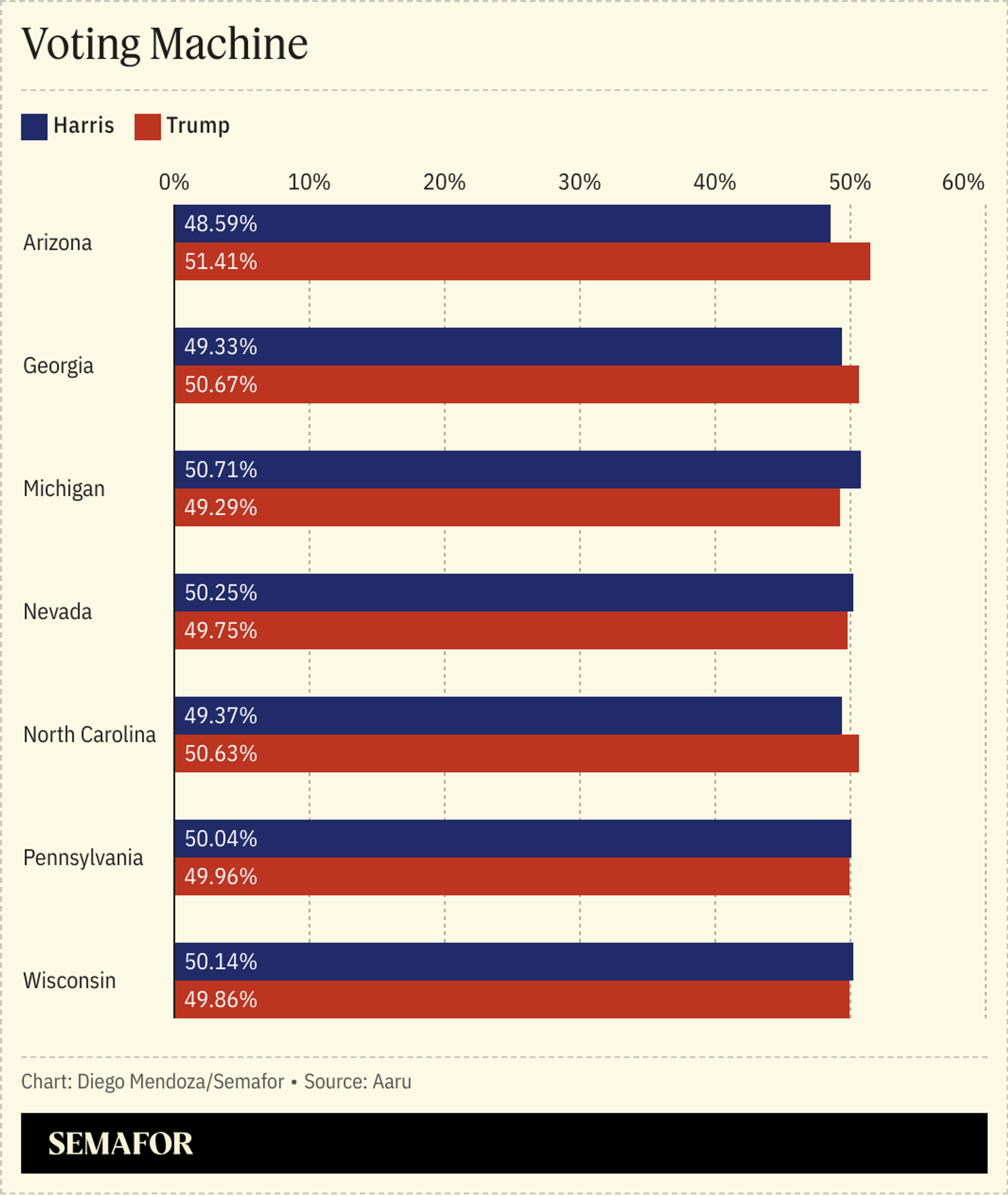The Scoop
Young entrepreneurs who think their AI chatbots can model human behavior better than humans can, agreed to put their model to the test in the 2024 election.
We wrote about the two 19-year-old college dropouts, Cam Fink and Ned Koh, and Aaru, the company they co-founded with 15-year-old John Kessler, two months ago. They use census and other demographic data to create thousands of AI avatars of voters, each with hundreds of personality traits to model the humans they’re supposed to mimic. The bots (“agents”) are fed with a diet of news and information those people might consume, and then asked about their preferences — in this case, who they would vote for. Fink and Koh say the tests they’ve run show their system is incredibly accurate — and much cheaper and faster to run than traditional polling.
So we asked them to put it to the test. They’ve recreated the electorate in key states with representative bots —a thousand or more in each state — and polled them about their preferences. The models had access to news up until midnight Sunday, so they would have heard about Donald Trump’s weekend rally in Pennsylvania and Kamala Harris’ in Michigan.
In this article:
Know More
Here’s how Aaru’s bots are voting in the presidential race in the seven battleground states:

They’ve run the simulation multiple times, and list the probability of Trump winning Arizona at 73.3%, North Carolina at 62.1%, and Georgia at 61.8%; meanwhile they have Harris’ odds of winning Michigan at 63.3%, Nevada at 53.4%, Pennsylvania at 52.4% and Wisconsin at 50.9%.
We also asked Aaru to look at three key Senate races, and here’s what they came up with:



They listed the probability of a Sheehy win at 92.5%, a Fisher win at 93.6% and a Brown win at 54.2%.
Gina’s view
If only bots vote, this will be one close election — and a narrow Kamala Harris victory.
And, yes, this sounds crazy. Not to mention has echoes of dystopian science fiction tropes, from the predictive “psychohistory” of Isaac Asimov’s Foundation series to the killer robots of TV’s Westword (minus the wholesale enslavement of humanity, at least so far).
But polling is at best an inexact science that tries to divine the intentions of a population by sampling a subset of the group; there’s plenty of potential for error up and down the process, not least because so few people are willing to answer a poll these days. Aaru’s agents, while imperfect humans, will always pick the phone, and given enough of them, their aggregated answers should in theory approach some version of reality.
In any case, Aaru’s system doesn’t need to drastically outperform traditional polls to show value; it only needs to be as accurate as them — or no worse than them — to outcompete them on speed and cost grounds.
Polls built on chatbots aren’t just numerical systems, either; because they have language models underpinning them, you can ask agents what drove their decision — for example, why in the example below, one of them switched from Trump to Harris in the last week.
“I’m a Republican, but I don’t always agree with everything Trump says — especially all the stuff about social media and online privacy. That’s really important to me. I value my independence and freedom online, and I’m very wary of government overreach in that area. I’ve been doing additional research, and lately, the news has really made me question Trump’s approach to this matter,” the agent, channeling a divorced woman living in a Colorado suburb, said.
At the end of the day, the proof of the pudding is in the eating, and we’ll revisit these predictions once the results are in.
Room for Disagreement
Researchers at Havard’s Ash Center for Democratic Governance and Innovation ran their own tests and found the potential for error if the bots are trained on out-of-date data.
Still, they concluded that “today, humans fill out the surveys and computers fill in the gaps. In the future, it will be the opposite: AI will fill out the survey and, when the AI isn’t sure what box to check, humans will fill the gaps.”
Notable
- Semafor’s Dave Weigel lists the 20 bellwether counties he’s keeping an eye on to see how key battleground states or voting groups are trending.
- AI is being used in polling in multiple ways in this election, including to reach potential respondents.
- Researchers at Brigham Young University built and tested their agent-based system last year and concluded that such systems “constitute a novel and powerful tool to advance understanding of humans and society across a variety of disciplines.”

